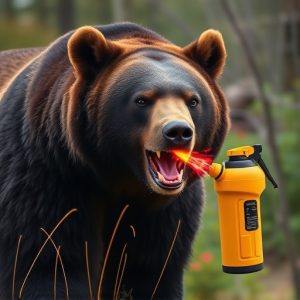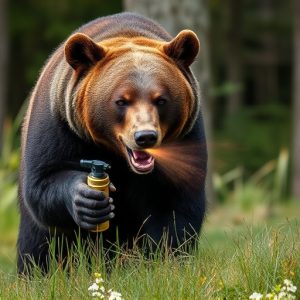Protecting Yourself: Bear Deterrents, Behavior, and Safe Hiking Tips
Understanding bear behavior is crucial for preventing aggressive encounters, especially with unpredi…….
Understanding bear behavior is crucial for preventing aggressive encounters, especially with unpredictable grizzlies. Pepper spray, a popular defense tool, remains effective against bears for several hours due to its active ingredient, capsaicin from chili peppers. However, its contamination duration varies based on wind and spray amount. Despite its potency, responsible usage is essential to minimize ecological harm and prevent unintended consequences for both humans and wildlife. In bear country, combining pepper spray with awareness, avoidance, and proper food storage is vital for safe navigation. Carrying a spray with a 20-30 foot range and practicing usage is advised, focusing on respect for bears' natural environment to prevent encounters.
In regions where aggressive bears roam, understanding their behavior and adopting effective protection measures are crucial for hikers and campers. This article explores several strategies to safeguard against bear attacks, with a focus on pepper spray as a popular deterrent. We delve into its effectiveness, durability, and potential environmental impact, including how long it contaminates the ecosystem. Additionally, alternative methods and responsible hiking practices are discussed to ensure safe interactions with these majestic yet potentially dangerous animals in their natural habitats.
- Understanding Bear Behavior: What Triggers Aggression?
- Pepper Spray: A Popular Choice for Bear Deterrent – Effectiveness and Durability
- The Science Behind Pepper Spray Contamination and its Impact on Wildlife
- Alternative Methods to Protect Yourself in Bear Country
- Tips for Responsible Hiking and Camping in Bear Habitats
Understanding Bear Behavior: What Triggers Aggression?
Understanding bear behavior is key to preventing and responding to aggressive encounters. Bears, especially grizzly bears, are unpredictable and can become defensive or offensive for various reasons. Their sense of smell is exceptionally strong, so they often detect humans from a distance, leading to curiosity or fear. Feeding behaviors can also trigger aggression; bears that associate humans with food may become bolder and more frequent visitors to human habitats.
Aggression in bears is often a result of feeling threatened, protecting their young or territory, or experiencing pain or illness. Unexpected movements or loud noises might provoke an attack, as bears naturally shy away from perceived threats. It’s important to remember that pepper spray, while effective against humans, may not deter aggressive bears for long periods; its effectiveness can vary based on the distance and concentration of the spray when deployed.
Pepper Spray: A Popular Choice for Bear Deterrent – Effectiveness and Durability
Pepper spray has emerged as a popular choice among outdoor enthusiasts and those living in bear country for its effectiveness as a deterrant against aggressive bears. Its active ingredient, capsaicin, is derived from chili peppers and causes temporary yet intense irritation to a bear’s eyes, nose, and respiratory system. This irritant reaction can prompt the bear to flee the area, providing valuable time for humans to escape or seek shelter.
One of the key advantages of pepper spray is its durability. Unlike other deterrents that may be washed away by rain or sweat, pepper spray remains effective as long as it’s used properly. The length of contamination depends on various factors such as wind conditions and the amount of spray used, but generally, it can remain potent for several hours, providing a reliable safety measure during outdoor activities in bear-inhabited areas.
The Science Behind Pepper Spray Contamination and its Impact on Wildlife
The use of pepper spray as a defense against aggressive bears has become a popular topic in outdoor safety discussions. However, understanding the science behind its contamination and impact on wildlife is crucial. Pepper spray works by irritating the eyes, nose, and respiratory system of an animal through capsaicin, the active ingredient responsible for the burning sensation. When used incorrectly or left unattended, pepper spray can contaminate the environment, leading to unintended consequences for both wildlife and humans.
The duration of pepper spray contamination varies depending on several factors, including the amount used, environmental conditions, and the sensitivity of the affected species. Studies suggest that pepper spray residue can remain active on surfaces for extended periods, sometimes up to weeks. This longevity poses a risk to curious wildlife that may come into contact with contaminated areas, potentially causing long-term health issues or even death. It’s essential for users to handle and store pepper spray responsibly to minimize its ecological impact.
Alternative Methods to Protect Yourself in Bear Country
In bear country, beyond noise makers and heavy-duty locks, there are alternative methods to enhance your safety. One increasingly popular option is pepper spray designed specifically for wildlife encounters. Unlike traditional pepper spray, this variety is formulated to minimize damage to the user while maximizing its effectiveness against aggressive bears. It’s a non-lethal deterrent that can provide precious time for escape or reconfiguration in case of an encounter.
However, it’s important to note that no single method guarantees 100% protection against bear attacks. The duration of pepper spray’s effectiveness varies, with most estimates suggesting it remains active for around 20-45 seconds – not long enough to ensure a safe escape from an aggressive bear. Thus, while pepper spray is a valuable tool in your safety arsenal, understanding its limitations and combining it with other defensive strategies like awareness, avoidance, and proper food storage is paramount in navigating bear country responsibly. In terms of how long does pepper spray contaminate, the active ingredient’s residue can persist for several hours, but its potency diminishes significantly over time after application.
Tips for Responsible Hiking and Camping in Bear Habitats
When hiking or camping in areas known for bear habitats, it’s crucial to adopt responsible practices. Always stay alert and make noise while navigating through forests to avoid unexpected encounters. Keep a safe distance from bears and never approach them, especially cubs. Proper food storage is essential; secure your food in bear-resistant containers or hang it at least 10 feet above the ground and 7 feet away from trees.
Bear pepper spray can be an effective deterrent, but be aware that its effectiveness depends on factors like wind direction and proximity to the bear. It’s recommended to carry a canister with a range of at least 20-30 feet and practice using it before venturing into bear country. Remember, the best defense is prevention through awareness and respect for these powerful animals in their natural environment.
In conclusion, understanding bear behavior and employing effective deterrents like pepper spray are key to staying safe in bear country. While pepper spray is a popular choice, it’s important to be aware of its contamination duration (How Long Does Pepper Spray Contaminate) and potential environmental impact. Alternative methods, combined with responsible hiking and camping practices, offer a holistic approach to protection. By following these guidelines, folks can minimize their risk while enjoying the outdoors and appreciating these magnificent creatures in their natural habitats.


